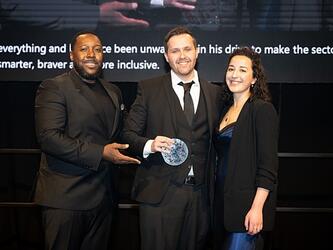Fresh perspective
When Dan Rusga joined family-owned dairy company Yeo Valley at the end of 2001, its star was in the ascendant. For the next six or seven years it enjoyed meteoric growth – sales rose by between 20% and 40% annually, fuelled by the popularity of organic produce.
“It was a joy, it was so easy,” recalls Rusga, who is now head of retail marketing. Retailers willingly devoted shelf space to the brand and welcomed new products. Then recession hit. “At the beginning of 2008 something started to happen, and in 2009 growth stopped.”
Discounters such as Aldi and Lidl capitalised on the fact that people had less disposable income after the crash, and the traditional grocers sought to defend their market share by launching private-label value brands. The shift put “huge pressure” on shelf space, says Rusga, and because organic sales had fallen, that’s where the space came from. “Consumers were buying slightly less of our brands, but it was the shelf space issue that gave us the most problems.”
Losing its fair share
Yeo Valley started out as a private-label supplier, primarily to Boots and Tesco, in the late 1970s. ‘Yeo Valley’ as a brand only came into existence in the early 1990s, after managing director Tim Mead advised some local organic farmers to form a co-operative and agreed to try and help make a market for the milk they produced. Mead’s decision to launch the Yeo Valley brand, and to make it organic, wasn’t based on research, but on his belief that it was the right thing to do from both an ethical and business standpoint, says Rusga.
While Yeo Valley’s private-label business grew during the recession, it was dependent on individual retailers’ strategies. For example, Tesco supported its own discount brands and value lines, but in the mid-market it supported major brands such as Müller and Danone. Asda, by contrast, focused more on the private-label market and launched its ‘Chosen by You’ mid-tier private-label range.
“So things ebbed and flowed, but the very big brands (those who could afford to advertise) did well, as did private-label,” says Rusga. “Our private-label sales continued to grow, but the product mix wasn’t always favourable. And brands in third, fourth and fifth place, including us, were squeezed.”
Yeo Valley survived as an independent business because of its balance between brand and private label and because of its broad customer base. But the top team knew that if the brand continued to lose share, the company’s long-term profitability would be compromised. It needed a new brand strategy.
“The financial year 2008/2009 was a watershed in terms of how we looked at consumer insight, because before that we were able to ride the organic wave,” recalls Rusga. “At the point where we needed to take stock, we brought in Big Fish, a brand consultancy, to help us try to see the wood for the trees. The initial work we did with them, ironically, took us back to our roots and what had started us off in the first place.”
Read the full article
in the digital version of Impact, the new quarterly magazine from the
Market Research Society.
Find out:
- How insight drives the development of both brand and private-label at Yeo Valley
- How identifying the brand’s ‘five heartbeats’ led to a design overhaul
- How insight workshops involving researchers, brand owners and retailers are used to support product innovation

We hope you enjoyed this article.
Research Live is published by MRS.
The Market Research Society (MRS) exists to promote and protect the research sector, showcasing how research delivers impact for businesses and government.
Members of MRS enjoy many benefits including tailoured policy guidance, discounts on training and conferences, and access to member-only content.
For example, there's an archive of winning case studies from over a decade of MRS Awards.
Find out more about the benefits of joining MRS here.













1 Comment
Anon
13 years ago
Great Article, but painful reading the conclusion through the impact magazine. Perhaps it reads well on a tablet, but very poor on a laptop or optional large monitor. Perhaps more research required....
Like Reply Report